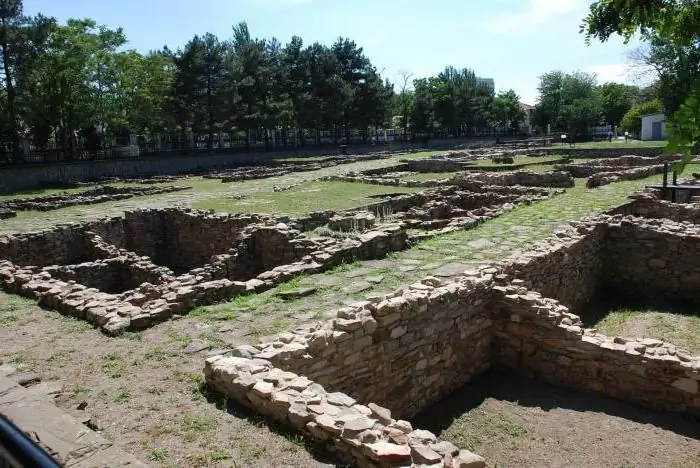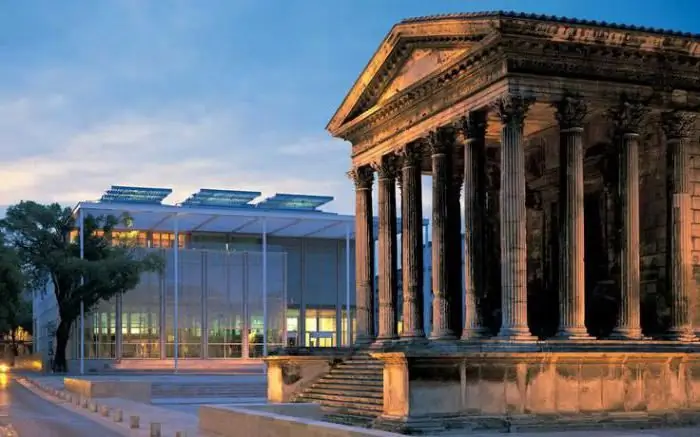- Author Harold Hamphrey [email protected].
- Public 2023-12-17 10:06.
- Last modified 2025-01-24 11:10.
Anapa is a resort town on the Black Sea coast of the Krasnodar Territory. Most tourists come here on their summer holidays, dreaming of swimming in the sea, sunbathing and visiting the water park. But if the described option seems too boring for you, you can always go on excursions. One of the most unusual and interesting places to visit in Anapa is the Gorgippia Archaeological Museum.
A resort town full of history
Unenlightened tourists are dismissive of the Krasnodar Territory when it comes to historical sights. In Greece and Spain, literally at every step you can see ancient ruins, but what can the Russian south boast of? In fact, the Krasnodar Territory has an equally interesting history, the full version of which, perhaps, we have yet to find out.

On the site of modern Anapa once was the ancient Greek city of Sindskayaharbor. Thanks to archaeological finds, it was possible to establish that it was founded no later than the 6th century BC. e. In the 4th century BC. e. the settlement passes into the subordination of the Bosporan kingdom and receives a new name - Gorgippia in honor of the ancient ruler Gorgipp. The city is developing rapidly and is famous as a craft and trade center. On the territory of Gorgippia there was a large quarter of master potters. In the second century BC. e. the city received the right to issue its own coins.
In the 2nd century A. D. e. Gorgippia is flourishing - the streets are decorated with skillful statues and obelisks, pompous temples are being built, we althy citizens do not spare money to create elaborate tombs and necropolises.
What happened to the rich ancient city? Why is only the Gorgippia Archaeological Museum left of it today? In the 3rd century A. D. e. the city began to be constantly subjected to barbarian raids. The once flourishing settlement ends its history in the 4th century AD. After another invasion of the Huns, Gorgippia disappeared forever from the world maps.
Museum exhibits
Archaeological excavations began in the 19th century. In their course, it was possible to establish that the ancient city occupied more than 40 hectares and is located under modern Anapa, at a level of only about 1 meter.

Today, the archaeological museum-reserve "Gorgippia" is located in the center of the resort town and covers an area of 1.6 hectares. Excavations and research activities are still ongoing here. A site of 0.7 hectares is open for tourists, fully researched andwhich is an open-air museum.
The Gorgippia Archaeological Museum invites everyone to take a walk around the real ancient city. During the tour you will see with your own eyes: the foundations and basements of residential buildings, streets, defensive buildings, wineries, drains, wells and a necropolis. Today it is the only archaeological museum in Russia that invites everyone to the excavation sites. There is also a pavilion on the territory of the reserve, which exhibits the most valuable and interesting exhibits.
Gems of the collection
The museum exhibits an interesting collection of ceramics. During the tour, tourists will find out how pithoi differed from amphoras, and what other forms of vessels were most often used by our distant ancestors. In addition to household utensils, the Gorgippia Archaeological Museum delights guests with a collection of women's jewelry and bijouterie. The real pearl of the exposition is an ancient loom. No less interesting to see are the statues and fragments of marble slabs with inscriptions in ancient Greek. Also in the museum's collection there are samples of weapons, tools and details of complex mechanisms.

Many unique and valuable exhibits are constantly exhibited in the largest museums in Russia - in Moscow and St. Petersburg. But, despite this fact, the permanent exhibition in Gorgippia itself is very interesting and informative.
Opening hours and prices
Anapa Archaeological Museum-Reserve "Gorgippiya" has been open since Tuesdaythrough Sunday inclusive. You can visit the exposition from 09:00 to 18:00. The cost of an adult ticket is 120 rubles, for children and beneficiaries the entrance costs 80 rubles. The following categories of citizens have the right to view the museum's collection at a reduced price: students, pensioners, the disabled, participants in wars, military contract servicemen, orphans. To receive a discount when purchasing a ticket, you must present an appropriate document confirming the preferential category.

How to get there? Address and directions
The exact address where the archaeological museum "Gorgippia" is located: Anapa, Naberezhnaya street, house 4. This is the very center of the resort town. The nearest public transport stop is called Astrakhanskaya. Travel by buses and fixed-route taxis No. 1, 2, 6, 16 and 18. The exact coordinates of the museum-reserve for motorists: 44.896262; 37.310507.
Reviews of tourists
The Archaeological Museum will most impress inexperienced tourists who do not expect to see such an attraction in a Russian resort town. The advantages of Gorgippia are the ridiculous cost of tickets, convenient location and quite interesting expositions. Remarkably, this museum has truly unique exhibits. For a small surcharge, you can order a guided tour service, the duration of which is 1.5 hours.

The Gorgippiya Archaeological Museum in Anapa is also interesting becauseis the only one in Russia. You should not compare it with the ancient museums of European resorts. "Gorgippia" is a relatively young museum and insufficiently studied. It is quite possible that very soon new interesting discoveries and archaeological finds await us.






